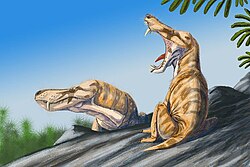| Alopecognathus Temporal range: Late Permian | |
|---|---|
 | |
| Skulls including that of the holotype (A-B) | |
| Scientific classification | |
| Domain: | Eukaryota |
| Kingdom: | Animalia |
| Phylum: | Chordata |
| Clade: | Synapsida |
| Clade: | Therapsida |
| Clade: | † Therocephalia |
| Family: | † Scylacosauridae |
| Genus: | † Alopecognathus Broom, 1915 |
| Species: | †A. angusticeps |
| Binomial name | |
| †Alopecognathus angusticeps Broom, 1915 | |
| Synonyms [1] | |
Genus synonymy
Species synonymy
| |

Alopecognathus is an extinct genus of therocephalian therapsids from the Late Permian of South Africa. [2] [1]


